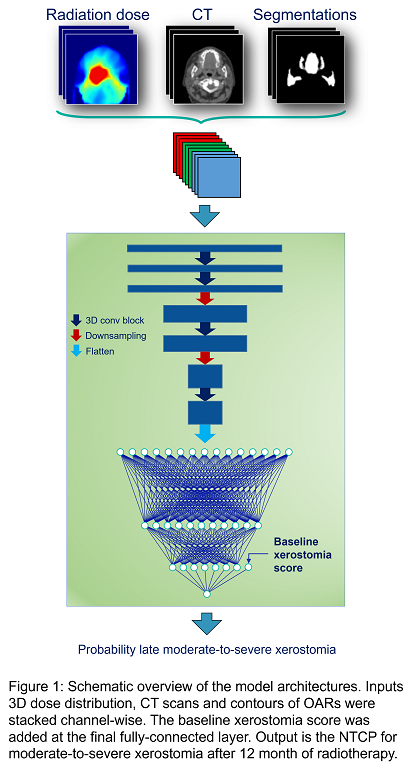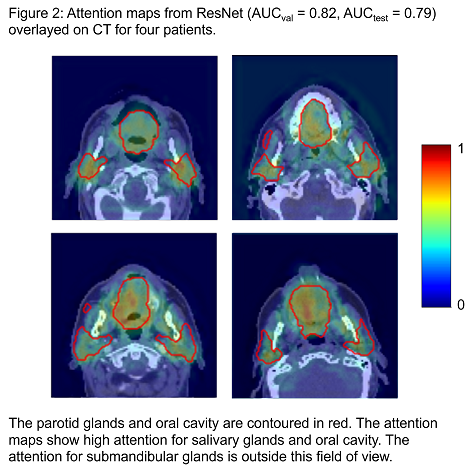Deep learning based NTCP-modelling using 3D-information for predicting late xerostomia
Hung Chu,
The Netherlands
OC-0449
Abstract
Deep learning based NTCP-modelling using 3D-information for predicting late xerostomia
Authors: Hung Chu1, Suzanne P.M. de Vette1, Hendrike Neh1, Nanna M. Sijtsema1, Roel J.H.M. Steenbakkers1, Clifton D. Fuller2, Johannes A. Langendijk1, Peter M.A. van Ooijen1, Lisanne V. van Dijk1
1University Medical Center Groningen, Radiotherapy, Groningen, The Netherlands; 2MD Anderson Cancer Center, Radiation Oncology, Houston, USA
Show Affiliations
Hide Affiliations
Purpose or Objective
Normal tissue complication probability (NTCP) models aim to predict radiation-induced toxicities. Conventional NTCP-models are typically logistic regression models that are based on discrete input variables. For xerostomia, a common radiation-induced toxicity for head and neck cancer (HNC) patients, current NTCP prediction is based on mean dose to salivary glands and baseline complaints. These features contain limited spatial information and thus may lack information required for more accurate xerostomia predictions. Deep learning (DL) models have the potential to improve the prediction of xerostomia as they utilize full 3-dimensional (3D) dose distributions and image information, rather than using 1D dose representations. The aim of this study was to develop a DL-based NTCP-model to predict xerostomia 12 months after HNC radiotherapy and to compare the prediction performance to a conventional NTCP-model.
Material and Methods
In total, 898 HNC patients were included that were treated with radiotherapy between 2007 and 2021. The cohort was split in a training (70%), internal validation (15%) and independent test (15%) set. The endpoint was patient-rated moderate-to-severe xerostomia after 12 month of radiotherapy (EORTC QLQ-H&N35). The 3D dose distributions, CT scans, organs-at-risk (OARs) contours and baseline xerostomia score were DL input (Figure 1). The following architectures were considered and optimized individually (i.e., hyperparameter tuning): 1) EfficientNet-v2; 2) residual neural network (ResNet), and: 3) deep convolutional neural network (DCNN). Model performance was evaluated with area under the curve (AUC) criteria in the validation and test cohort.
DL model performance was compared to that of the recently published xerostomia NTCP model by Van den Bosch et al. (2019), which includes the mean dose to salivary glands and baseline xerostomia score. Finally, attention maps were created to visualize regions of the input image where the DL model focused on when making predictions.

Results
Each DL model obtained higher validation (with AUC between 0.79 and 0.82) and test (with AUC between 0.78 and 0.79) performance than the conventional NTCP-model (AUC-validation = 0.75, 95% CI [0.67 – 0.83]; AUC-test = 0.75 [0.67 – 0.84]). This demonstrates the benefit of utilizing 3D information for the prediction of late xerostomia. The ResNet model performed best with validation AUC = 0.82 ([0.73 – 0.89]) and test AUC = 0.79 [0.70 – 0.87]. Hyperparameter tuning showed highest internal validation performances for AdaBound optimizer, learning rate of 0.0001 and batch of 8. Furthermore, attention maps showed that ResNet focused on salivary glands and oral cavity when making its prediction (Figure 2).

Conclusion
DL-based models using 3D dose distribution, CT, OAR segmentations and baseline xerostomia score showed good performance in terms of AUC, and outperformed the conventional logistic regression-based NTCP-model. Furthermore, the DL models have potential to improve clinical decision-making.